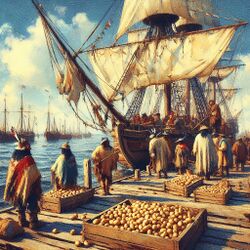Canespa-Burgoignesc relations: Difference between revisions
mNo edit summary Tag: 2017 source edit |
mNo edit summary Tag: 2017 source edit |
||
| Line 8: | Line 8: | ||
During that time, the [[Veraise colony]] traded with [[Canespa]] for food stuffs and potatoes, a stable food staple that transported well. The trade route and relations cooled when the [[Veraise colony]] was sold to [[Ehemo]] in [[1812]]. After the [[First Fratricide]] ([[1848]]-[[1875]]), [[Burgundie]] and [[Canespa]] reengaged in relations and [[Burgundie]] started carrying many of [[Canespa]]'s goods, but especially potatoes, all over the world. | During that time, the [[Veraise colony]] traded with [[Canespa]] for food stuffs and potatoes, a stable food staple that transported well. The trade route and relations cooled when the [[Veraise colony]] was sold to [[Ehemo]] in [[1812]]. After the [[First Fratricide]] ([[1848]]-[[1875]]), [[Burgundie]] and [[Canespa]] reengaged in relations and [[Burgundie]] started carrying many of [[Canespa]]'s goods, but especially potatoes, all over the world. | ||
[[1923]] Treaty of Foxhey, the | [[1923]] Treaty of Foxhey, the [[Port Extranjero]] was given to the nation of [[Burgundie]]. It occupies 7,500 acres (3,000 ha) of land and water with 43 miles (69 km) of waterfront. The port's channel depth is 16 m (53 feet). The port has 25 cargo terminals, 82 container cranes, 8 container terminals, and 182 km (113 miles) of on-dock rail. Promoted as the "Gateway to the [[Cusinaut]]", the port is located in XXX Bay, approximately 22.5 km (14 miles) west of downtown Extranjero. The port was initially opened on December 9, [[1926]], after 3 years of construction. The land the port is built on was given to [[Burgundie]] under the provisions of the Treaty of Foxhey, in [[1923]] which exchanged the land to [[Burgundie]] in exchange for security guarantees and protection for [[Canespa]]. | ||
==See also== | ==See also== | ||
*[[Foreign Relations of Burgundie]] | *[[Foreign Relations of Burgundie]] | ||
Revision as of 17:33, 8 January 2024
This article is a work-in-progress because it is incomplete and pending further input from an author. Note: The contents of this article are not considered canonical and may be inaccurate. Please comment on this article's talk page to share your input, comments and questions. |
| This article is a stub. You can help IxWiki by expanding it. |

Burgundie and Canespa have maintained formal relations since the early 1700s when merchant explorers from the Veraise colony came in contact with coastal settlements in Canespa.
During that time, the Veraise colony traded with Canespa for food stuffs and potatoes, a stable food staple that transported well. The trade route and relations cooled when the Veraise colony was sold to Ehemo in 1812. After the First Fratricide (1848-1875), Burgundie and Canespa reengaged in relations and Burgundie started carrying many of Canespa's goods, but especially potatoes, all over the world.
1923 Treaty of Foxhey, the Port Extranjero was given to the nation of Burgundie. It occupies 7,500 acres (3,000 ha) of land and water with 43 miles (69 km) of waterfront. The port's channel depth is 16 m (53 feet). The port has 25 cargo terminals, 82 container cranes, 8 container terminals, and 182 km (113 miles) of on-dock rail. Promoted as the "Gateway to the Cusinaut", the port is located in XXX Bay, approximately 22.5 km (14 miles) west of downtown Extranjero. The port was initially opened on December 9, 1926, after 3 years of construction. The land the port is built on was given to Burgundie under the provisions of the Treaty of Foxhey, in 1923 which exchanged the land to Burgundie in exchange for security guarantees and protection for Canespa.